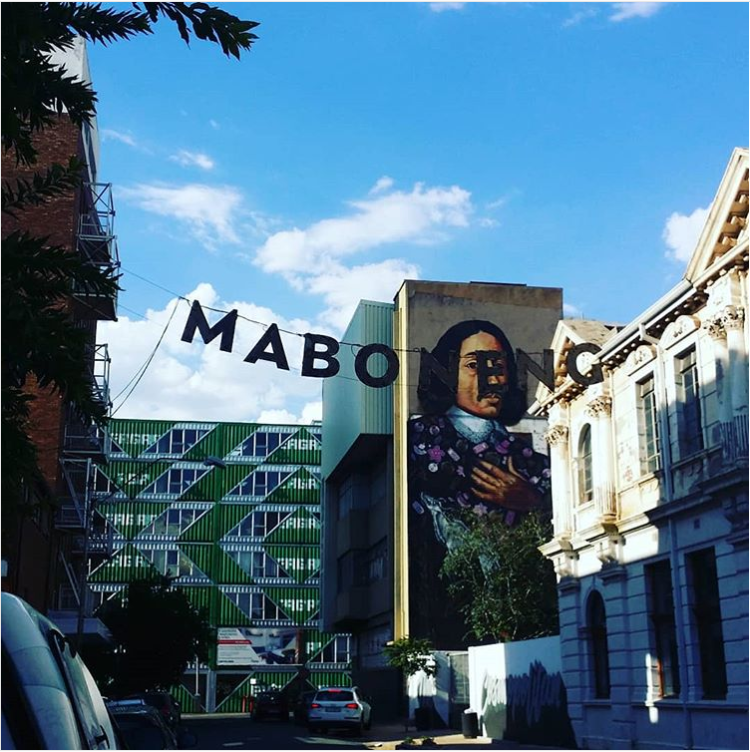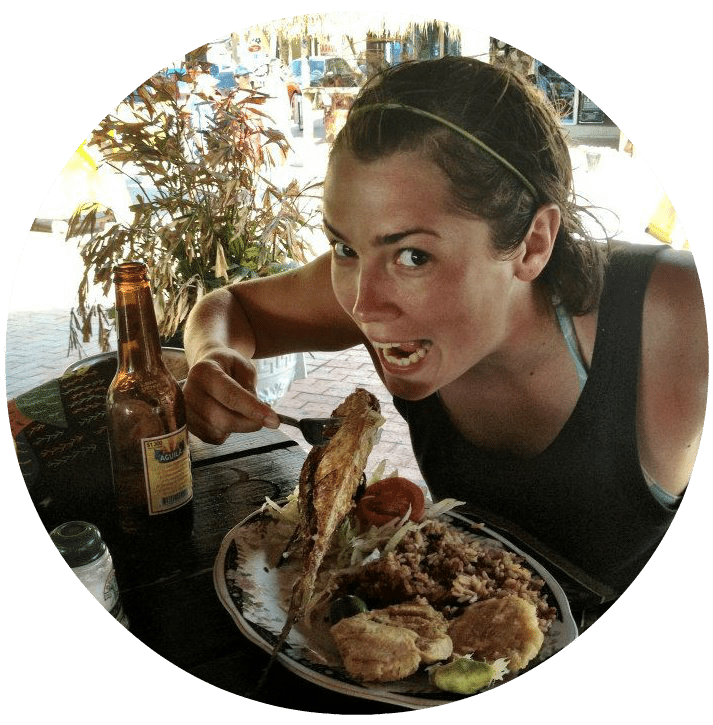Have you ever been walking through a neighborhood in a foreign city when the feeling you definitely should not be walking there began to creep up on you? This is one of those stories.
With a quick, two-day stop in Johannesburg on our way home to Cape Town, I researched “cool neighborhoods in Joburg” and was introduced to Maboneng: a beacon of hip rooftop bars and art galleries near the city center, its own gentrification still struggling to make peace with the crumbling reminders of what it used to be on each corner. One block is adorned with chic African clothing shops, the next, liquor stores where business is done between steel bars and a “pub” that has likely never seen a white face cross its threshold.
Alas, there is no “making peace” with gentrification. It comes and takes over everything and those who are still drinking in plastic chairs on the sidewalk outside their dilapidated car repair shops will soon be forced to evacuate when their building is sold to make industrial-style lofts.
Gentrification is one of those good things that feels like an evil thing and is, in reality, very much of both. It’s good for cities, for economies, for business, and for the many locals who can take advantage of the new money to revitalize forgotten places. It’s bad for the vast majority of those who never escape the forgotten part.

street art + shipping container apartments = gentrified.
As Maboneng’s transformation is still relatively new, the neighborhood can be fully explored in a day or two and I wanted to see more of Joburg. I wanted to see the real Joburg. After living in Cape Town for five months, I have mentioned to my husband several times that we weren’t in the “real Africa.” Much of Cape Town is a white-washed safe space of trendy restaurants and eight-foot retaining walls. Sure, there are black people in Cape Town. But they are either begging for money on the street, working as a parking attendant, or serving you your dinner. At any mid-range restaurant on a Friday night, you will find more white faces than black, unless you count the waiters.
The racial divide in Cape Town is stark and unspoken as far as I’ve seen–other than that time when our neighbors warned us “they” might jump that eight-foot wall with an electrified fence surrounding our house to steal our LED TV. Startled by the pronoun and wondering what exactly was meant, she knowingly clarified, “Oh, you know, them, the baddies.” I’m sure “the baddies” isn’t just a word for black people, but I am also sure that there aren’t any white people in this broadly-brushed concept of people who might come rob you at any minute.
Maboneng, however, offered something different. Here was the first I had seen of the black African middle class. Out to dinner at a delicious African restaurant, Pata Pata, we were one of only a few white tables. I was starting to think, hey, Joburg actually has this down. In a country that is eighty percent black I was relieved to finally be the minority, as I should be.
As one of my favorite ways to get to know a city is to walk around it somewhat aimlessly, that was the plan for our last day. I had read that the CBD was dilapidated; I had read that many of the businesses moved out, essentially relocating the CBD to a safe, suburban haven. They were right. We walked in the general direction of a museum, MuseuMAfricA, which took us directly through the city centre. In the heart of what should have been–or used to be–the financial district, “For Let” signs hung from almost every building. Hawkers lined the streets selling loose cigarettes or fruit or candies or bootleg DVDs. Trash choked the curbs and with each short burst of hot summer wind, a breath of garbage and another dirty plastic bag blew past us.
“Isn’t this different than anything you’ve ever seen before?” I asked Hudson.
“Just because it’s different, doesn’t mean it’s good.”
“Yeah, but this life. That this is the life for so many people. We don’t see it in Cape Town. We see the townships as we drive by with our doors locked, hoping not to get robbed. But we never just see the daily life. It’s not beautiful or glamorous or a tourist attraction, but it’s good to see it, to experience it. We need to get out of the bubble sometimes.”
Out of the bubble we certainly were. As we continued walking, past City Hall and other fancy buildings that should have been nicer than they were, the level of garbage undulated from block to block. For the most part though, other than a few clothing stores and fast food joints, everything was shuttered or falling apart.
Hudson was reluctant to continue. Why are we even going to this museum? It was a long walk, three miles each way, and by the time we got there, the skyline had receded to nothing but empty parking lots. Was this even the right place? Before we had a chance to second-guess ourselves any further, there it was: MuseuMAfricA. It was a massive old warehouse that used to be the home of a large marketplace, likely once filled with stalls and people and…anything. The empty parking lot was cracked with neglect and the fanciful Arabian facade barely looked open save for a small informational sign. As we entered, we realized we were the only ones there. The vast space of the interior made a museum too large for its contents: empty rooms and bare walls speckled through makeshift, unfinished exhibits.
We explored the three-story museum for over an hour, saddened by more of the tragic history of colonialism and racism in Africa and decided it was time to get some food and day beers to help drown our white guilt. A quick search of the surrounding area revealed nothing but fast food fish ‘n chips and a KFC. We started our walk back to Maboneng through the fashion district, hoping to stumble across something along the way.
Instead of stumbling across food or fashion, the poverty only seemed to intensify. Though I hadn’t yet felt unsafe, an uneasiness was rising in my gut. We had been walking through markets, past vendors and hawkers for over three miles, and no one had tried to sell us anything. In every third world market I have ever entered, the presence of a white tourist means it’s time for the hawkers to get into your face and hope you succumb to the annoyance of their insistence. But here, not a single person said a word to us. Why weren’t they trying to sell us anything?
I am not stupid, and we knew we weren’t walking through the park. Hudson left his fancy GPS watch at home and I walked with my purse slung across my chest, gripped at my hip in case they slashed the strap. I was careful to only take out my phone when we needed directions. We were being smart, and we didn’t really feel unsafe up to that point. But the unease intensified. I realized I hadn’t seen a single white person since Maboneng. Not even in a car. And all those middle class blacks from dinner last night? Nowhere to be found. In a country as racially charged and segregated as South Africa, in a city as notoriously violent as Johannesburg, it wasn’t a good sign.
Hudson had been warned of a neighborhood just north of the fashion district, Hillbrow: one of the poorest, most crime-ridden neighborhoods in the whole country. We suddenly realized that maybe we were a little too close. My eyes started darting around to everyone who passed. We passed yet another makeshift “market” set up in the dirt remnants of a crumbled side street. The smell of trash overwhelmed us both, stronger than ever before. My hand clutched my purse a little tighter as I tried to keep a happy and unassuming expression on my face. I didn’t want anyone to think I was nervous. Act like you belong, just act like it’s fine. A child bumped into me and I assumed I had been pickpocketed. I struggled to swallow a yelp as he made contact. I felt as though we were being followed. I checked behind me, but couldn’t tell.
Another person bumped into me and the thought played through my head yet again: Am I being ridiculous? Am I right to be nervous or am I overreacting? How do you know if your instincts are right or if you’re just being scared?
I took out my phone once again to confirm we weren’t walking into a dead end or a highway of some sort. As I looked around–surely the target-shaped look of a lost tourist on my face–a security van pulled up next to us.
“You need to be verrrry careful out here,” the uniformed guard warned gravely. “And make sure you aren’t being followed.” Before driving away he added, “And put your phone away.” Two guys who had been behind us seemingly scurried away at the sight of the van.
“We just have a few more blocks to go, but thank you.” I replied nervously.
Just back through the car repair shops. Then we would be OK. Hudson and I walked faster, but feigned casual. An unmarked van pulled up beside us and slowed without stopping. Were they following us? Were we about to get thrown in there? Why were they creeping so slowly? After over a minute of creeping beside us the van pulled away without incident, but we were already hyper aware of everything, every car, every person, every danger.
We passed the last of the grimy, makeshift repair shops and turned right into Maboneng. Suddenly, music lilted in the air as people shopped the numerous upscale art stores and clothing boutiques lining the street. We had crossed a threshold into another world. Hipsters drank ciders on tables outside of container bars. People were well-dressed. People were white. People were oblivious to the Joburg just two blocks away. In an instant, we were back in the bubble.
That night, Hudson and I contemplated what happened. I did some research and found that there was probably a ninety percent chance of us getting robbed walking where we were. Most cities have dangerous neighborhoods, that’s nothing new. But usually the CBD is the one place you can count on being safe, developed, and protected. Pickpockets, sure, but not kidnapping, not murder. We both felt immeasurable relief tinged with worry about what could have been. The thing about crime in South Africa that I didn’t realize before I came here was how racially charged it is. In D.C., you’ll get mugged, sure. But they don’t want to hurt you. They just want your money. Here, there is an anger, a hatred, a resentment that exists at the surface of every crime committed. They hate you because you are white. They want to hurt you, to rape you, because you are white. And instead of just stealing your phone or your wallet, they will beat you to death or stab you because you are white. At least that’s what all the white people are saying.
As we sat in our trendy Airbnb in Maboneng overlooking both the broken windows of the run-down warehouse and the trendy loft apartments with the rooftop bar across the street, I felt relieved and conflicted. I apologized to Hudson because I was the one who unknowingly forced us to explore the ghettos of Joburg. I felt stupid for wanting to get out of the bubble only to be so grateful once we made it back in. We probably dodged a bullet that day–and that is a strange idea to come to terms with in a (somewhat) literal sense.
I will never walk through the CBD in Joburg again. I have heard the CBD in Durban is equally as uninviting. I will do my research and listen to my instincts when they tell me something isn’t right. But more than anything, I will wish for a day when black people don’t have to be scared because they are black and white people don’t have to be scared because they are white, no matter which country or city or neighborhood they’re in.









Good God, I figured if you were ok if you’d lived to write but frankly this scared the hell out of me. Don’t do that again! And I think I’ll stick with Tanzania.
Great post! Thanks for sharing this amazing post.